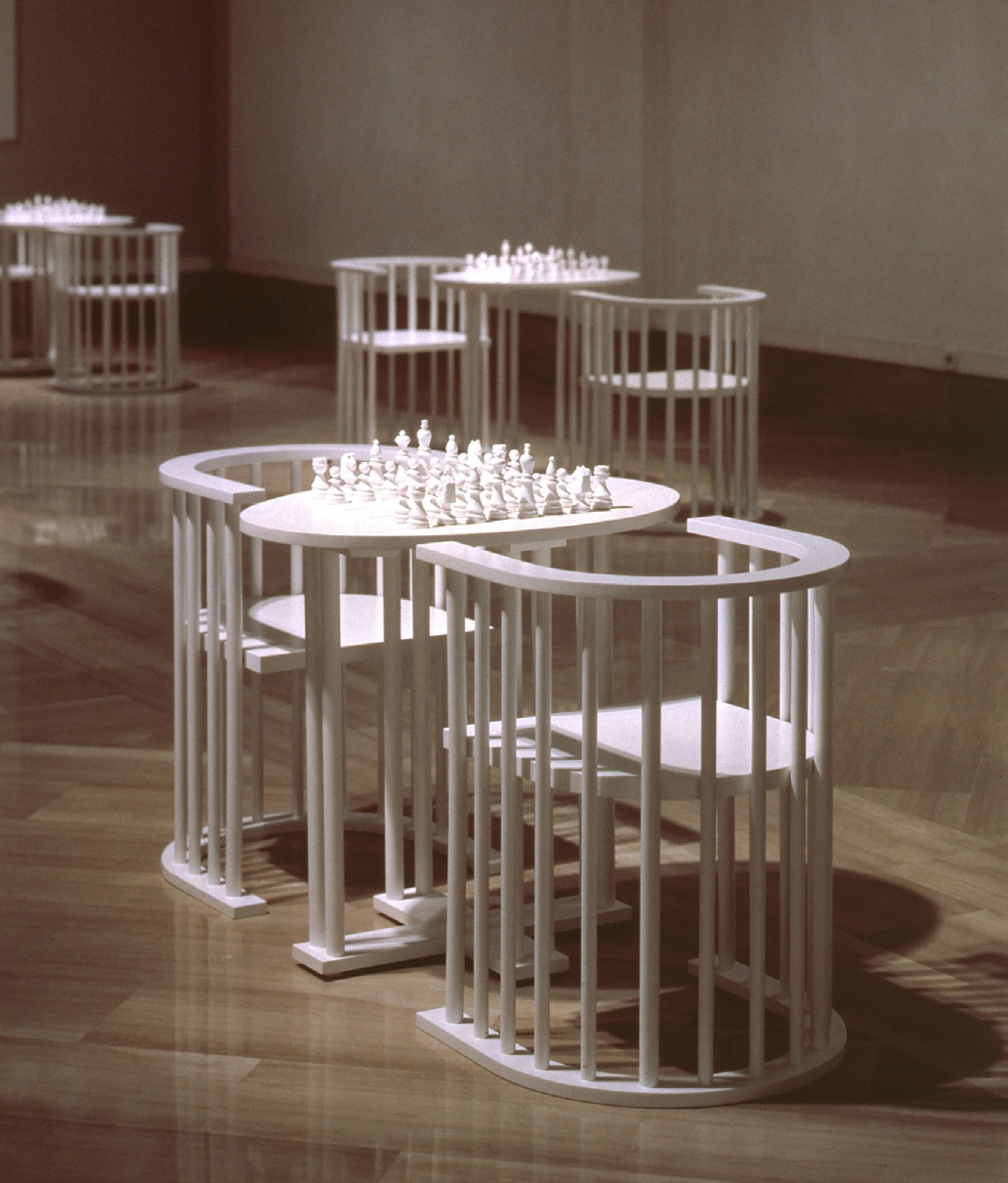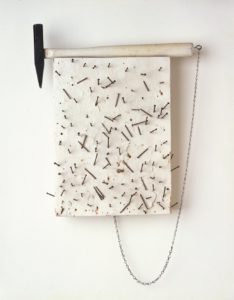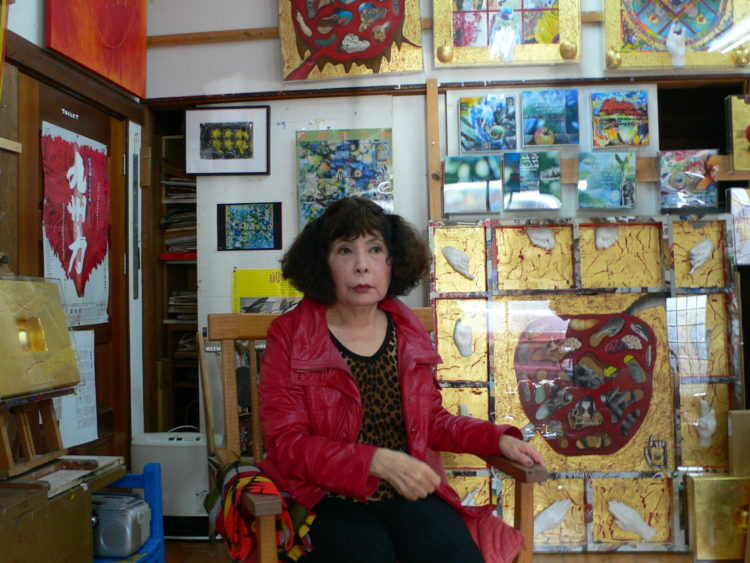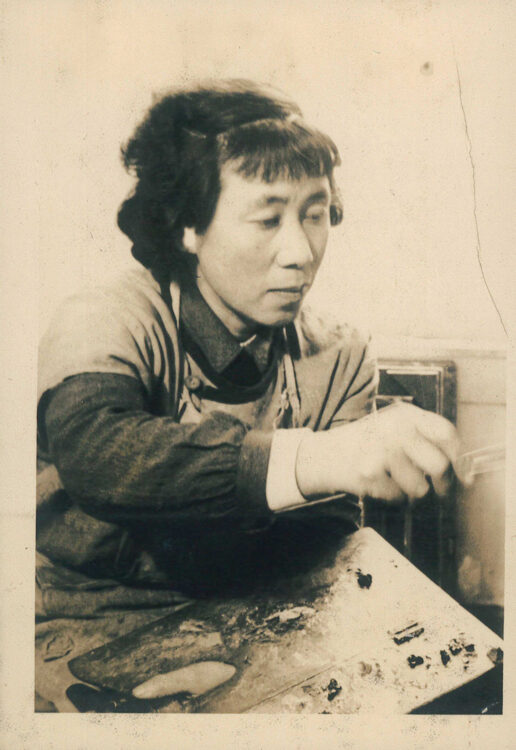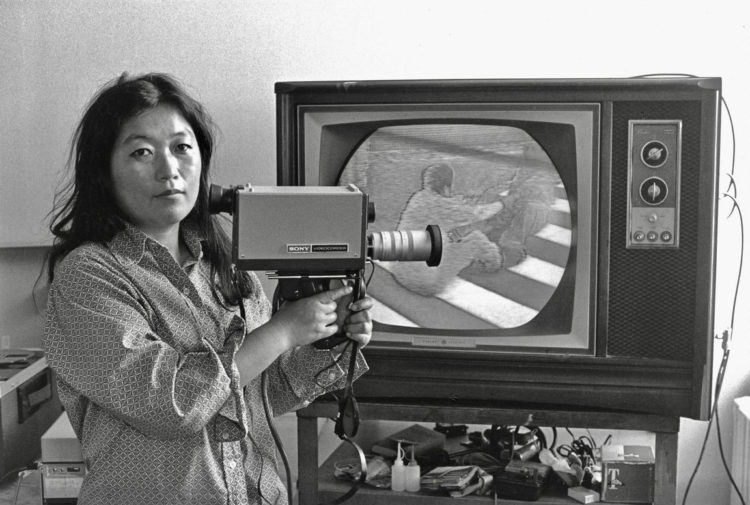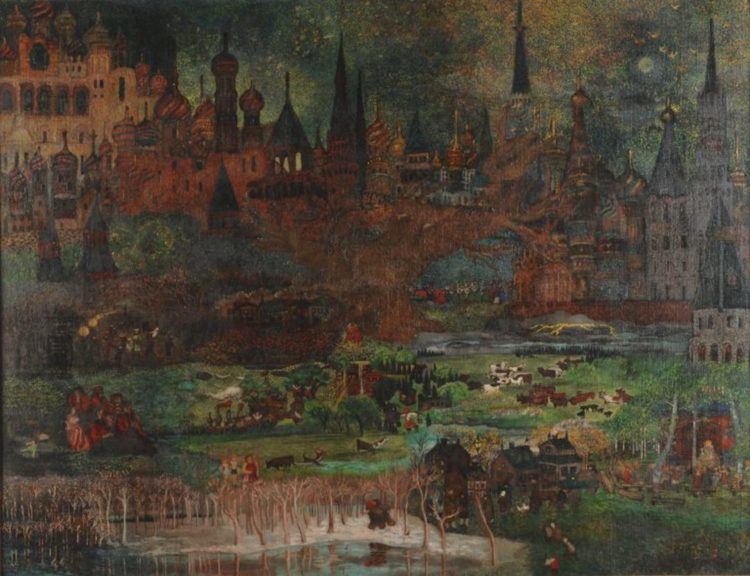Research
Yoko Ono, Play It by Trust (Valencia version), 1966/1997, installation view in the exhibition En Trance – Ex It, Lonja del Pescado, Alicante, Spain, 23 June–25 July 1997. Photo: Miguel Angel Valero © Yoko Ono
Nails, jars, ladders, doors, rags, piles of dirt, and yes, of course, an apple. Such is the view that greets us as we discover Yoko Ono’s first European retrospective, organised by MAC Lyon1 in close collaboration with the artist and Jon Hendricks.
It is an emotional journey through the artist’s career, from the works shown at her first monographic exhibition at the AG Gallery New York in 1961 to her latest pieces. It immerses us in a world of humble materials, simple words, and succinct yet highly illuminating sentences.
Words have been present throughout her work since Secret Piece, in 1953. This piece, which is the result of an unsatisfactory attempt to transcribe birdsong into music, consists in sheet music in which the treble clef stave features the sentence “with the accompaniment of the birds singing at dawn”, and the bass clef a repetition of the note F. A few years later, a sentence explaining the conditions in which the piece must be created was added before the stave, specifying that the chosen note was to be repeated with the musical accompaniment of birdsong and woods in the summertime between 5:00 and 8:00 a.m. While the score indicates the type of sound – birdsong –, it also lets our imagination and the various situations that ensue determine the melody. By using such concise and elusive language, the artist confuses matters so that we forget whether the birds are singing along with us or vice versa. With this first instruction, the artist modifies our attitude toward the score. The words enable the piece to materialise by adding a poetic and visual dimension to the music. In doing so, Yoko Ono gives the text a new purpose. It becomes the work itself, the place where it is conceived, whether tangibly or in one’s mind, where anyone can activate it many times over and eternally, each time in a different way.
This approach is distinctive of the artist’s entire body of work, in which she uses instructions to provide everyone with a framework for their actions or thoughts that can take on an infinity of different traits, depending on one’s interpretation. This perpetual freedom makes it possible to widen the traditional characteristics of the art object.
As Yoko Ono said: “The instructions gave me the freedom to do all sorts of things that you can’t do in the material world. For instance, to mix three paintings in your head; you can’t do that successfully in reality. With instructions, you can make a painting of four dimensions, five dimensions, even six dimensions. The point is, you can fly in your head. So I got a lot of benefit from instructionalising paintings.”2
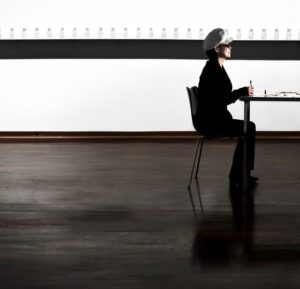
Yoko Ono, We Are All Water, 2006. The artist in her installation, We Are All Water, YOKO ONO: BETWEEN THE SKY AND MY HEAD, Kunsthalle Bielefeld, Bielefeld, Germany, 24 August – 16 November, 2008. Photo : Stephan Crasneanscki © Yoko Ono
The first Instructions Paintings (of which some reconstitutions are shown in Lyon) were first presented at the artist’s loft on Chamber Street in the winter of 1960, then at her first personal exhibition at George Maciunas and Almus Salcius’ AG Gallery on Madison Avenue3 in 1961. They consist of thirteen paintings and objects, including a picture, three of which come with a typed or hand-written note4 giving instructions on what to do. Yoko Ono was present at the events at the loft and AG Gallery, and used these written and oral instructions to invite the viewers to accomplish physical or mental actions. Sometimes the title was enough to guide the public, such as in Painting Until It Becomes Marble, and sometimes the written note was essential to prompt participation. This is the case for Painting to Be Stepped On, in which Yoko Ono encourages the public to enter the pictorial space by walking on a piece of coarsely cut canvas laid out on the floor.5 Some works only require mental participation, such as Painting to See in the Dark or Painting to Let the Evening Light Go Through. In general, the Instructions Paintings are “paintings to be constructed in your head”6 works that enable an exploration of the invisible. This is why Yoko Ono only showed written instructions a year later at the Sogetsu Art Centre. There were no paintings or objects with the 38 Instructions for Paintings, therefore suggesting a vision, a reflection free from all limitations. At the same time, by only presenting texts hand-written in Japanese by her then husband, the composer Toshi Ichiyanagi, the artist chose to show objects with a form that had been determined by someone else while also transcribing her own idea.
These instructions and other similar ones7 (Instructions for Photographs, etc.) were only published in 1964 in Japan, in the volume Grapefruit, by Wunternaum Press, the publishing house the artist founded for this purpose. As Mathieu Copeland wrote8, Grapefruit was a manual for anyone to produce art, a “DIY manual”, the openness of which offered a wide range of interpretations. This capacity gave it the power to abolish the aura of art and to strengthen its ephemeral nature. For Yoko Ono, “Art is not a special thing. Anyone can do it. […] If everybody were to become an artist, what we call ‘Art’ would disappear”.9 According to Yoko Ono, this concept, which was popular at the time and had also been formulated by others, such as Fluxus artists and Joseph Beuys, resulted in the idea that the democratisation of art, beyond the dematerialisation of art as an object, would lead to the disappearance of art. Art might therefore be a gesture, an immaterial element, an instant in the flow of life. Through her words, the artist gives us the key to access this ephemerality, which has always played an important role in Japanese culture due to the country’s positive view of impermanence.10
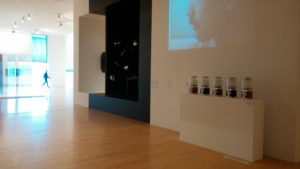
Exhibition view: Yoko Ono, Lumière de l’aube, © Yoko Ono 2016
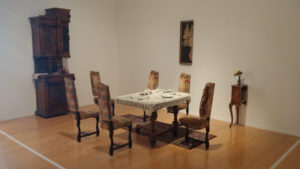
Exhibition view: Yoko Ono, Lumière de l’aube, © Yoko Ono 2016
In her Instructions, her interactive works, her static environments, and her performances, Yoko Ono formulates the concept of an “instructure”.11 Her “instructures” are starting points that are never definitively constructed. They are based on participation, the superposition of actions and thoughts, or the communion of action and thought. Therefore, they are ephemeral architectures that become part of a space only for a limited length of time, sometimes a very short instant, and die and reappear while constantly renewing themselves.
Like other inactive instructions, Blue Room Event is intended to nourish the mind. Created for the first time at her apartment in New York during the winter of 1965-1966 in a small, entirely white space, this piece consists of sentences that the artist wrote directly on the wall. The words modify the way the visitors perceive the space around them and the time they spend exploring it. Among these sentences, which have been reproduced in Lyon, one can read “this line is a part of a very large circle”, “this room is bright blue”, “there is not here”; and on the ceiling, the world YES. One year later, in 1966, at the Indica Gallery in London, a magnifying glass and ladder were added to enable the visitors to get a closer look at the YES.
The exhibition at the Indica Gallery also featured several Unfinished Objects. At first sight these pieces seem finished. Perched on clear Plexiglas pedestals, which highlight their fragile and immaterial nature, they nonetheless present themselves as emblems. On each pedestal, a very short instruction prompts a different perception of the object. The word APPLE next to a green apple does not only express a simple acknowledgement, especially in the perspective of an extended exhibition of the piece. The apple gradually decomposes and becomes unrecognisable, leaving the word as the only reminder of its existence. It is a thoroughly immaterial word, and yet it possesses a very concrete evocative power.
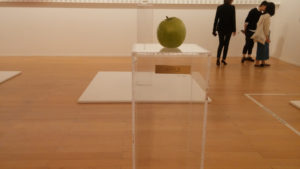
Yoko Ono, Apple, 1966, Plexiglass pedestal, brass plaque, apple, 114.3 × 17 × 17.6 cm, 45 × 6 7/10 × 6 9/10 in, exhibition view: Yoko Ono, Lumière de l’aube, © Yoko Ono 2016.
The mere presence of the title Box of Smile allows the furtive image of a smile to remain symbolically imprinted in a box containing reflective surfaces that send back the smile of the person who opens it.
Ephemerality is the fleeting, passing moment in which one perceives the complexity of the present time and of the moment experienced. Ephemeral manifestations, which take shape through elusive spatiotemporal coordinates, are by nature unstable and destined to disappear.
Destruction, just like modification and reconstitution, are themes that the artist often includes in her work, such as in Mend Piece, made up of pieces of broken crockery that the public is invited to glue back together. This work also symbolises the function of the individual gesture in collective life. It is a communion that celebrates ephemerality and art as a moment in the flow of life, which are also expressed in works like Half a Room, where all the elements of a living room – from cupboard to chair and from painting to fork – are cut in half, symbolising a world where one thing complements another. This is also the case in Promise Piece, in which a vase is broken and the pieces taken away by members of the audience, who promise to meet up 10 years later to reconstitute the vase. Another piece also evokes this perpetual exchange: the Air Dispenser distributes air capsules, reminding us how precious this invisible and intangible element is – “the only thing we share” and which unites us.12
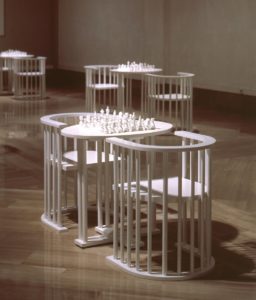
Yoko Ono, Play It by Trust (Valencia version), 1966/1997, installation view in the exhibition En Trance – Ex It, Lonja del Pescado, Alicante, Spain, 23 June–25 July 1997. Photo: Miguel Angel Valero © Yoko Ono
At the heart of this poetics of ephemerality, at the crossroads between ethics and aesthetics, is the opposition of continuousness and discontinuousness expressed by the “instant of life”, both punctual and eternal, between epiphanic outburst and stream of consciousness. It is suggestive of the tension between presence and absence.
In Yoko Ono’s work, the object evaporates, disappears with the help of words. While reality tends to become evasive and gradually vanish, words evoke mental images that paradoxically persist for a few moments, tangibly, through their communion with the flow of life. Of course, evanescence affects both the object and the word. During the “Dias (Destruction in Art Symposium)” in London in 1966, Yoko Ono performed Whisper Piece: To Destroy a Word. She whispered a word that was then repeated from mouth to ear around the room until it gradually changed and faded altogether. Her constantly mutating work is based on the word and on the opposition that it enables her to create between what is real, mental, material, and immaterial. Very early on in the history of conceptual art, Yoko Ono used the expansive capacity, ambiguity, and allusive power of words to construct an evanescent and unreal world, made up mostly of mental images that render a collective flow of life, creating an ephemeral and powerful imaginary architecture.
8 May-17 July 2016.
2
Yoko Ono in Julia Peyton-Jones and Hans Ulrich Obrist, “Interview with Yoko Ono”, in Yoko Ono, London: Serpentine Gallery, p. 34-40.
3
“Paintings and Drawings by Yoko Ono”, AG Gallery, New York, 17-30 July 1961.
4
Painting to Be Stepped On, Painting in Three Stanzas, Painting for the Wind. The typed note comes with the first piece, whereas the other two are hand-written by Ichiyanagi Toshi.
5
She prefigured this work in an instruction written in the winter of 1960: “Leave a piece of canvas or finished painting on the floor or in the street.”
6
Yoko Ono, conf. 13 Jan. 1966, “To the Wesleyan people”, on the occasion of the exhibition The Stone, Judson Memorial Church, New York.
7
There are 151 of them.
8
Mathieu Copeland, “De Bouche à oreille”, in Yoko Ono Lumière de l’aube, Lyon, Paris: MAC Lyon, Somogy, 2016, p. 23-27.
9
Yoko Ono, 1964, quoted and translated by Midori Yoshimoto, “Some Young People – From Non Fiction Theater”, Review of Japanese Culture and Society, Dec. 2005.
10
Christine Buci-Glucksmann, Esthétique de l’éphémère, Paris, Galilée, 2003.
11
Jon Hendricks, “À propos d’Instructure de Yoko Ono”, in Yoko Ono Lumière de l’aube, Lyon, Paris: MAC Lyon, Somogy, 2016, p. 17-20.
12
Yoko Ono, “Some notes on the Lisson Gallery Show”, cat. Yoko Ono at Lisson, 1967: “It is sad that the air is the only thing we share.”
Annalisa Rimmaudo, "Yoko Ono and the poetics of ephemerality." In Archives of Women Artists, Research and Exhibitions magazine, . URL : https://awarewomenartists.com/en/magazine/yoko-ono-et-la-poetique-de-lephemere/. Accessed 4 July 2025
